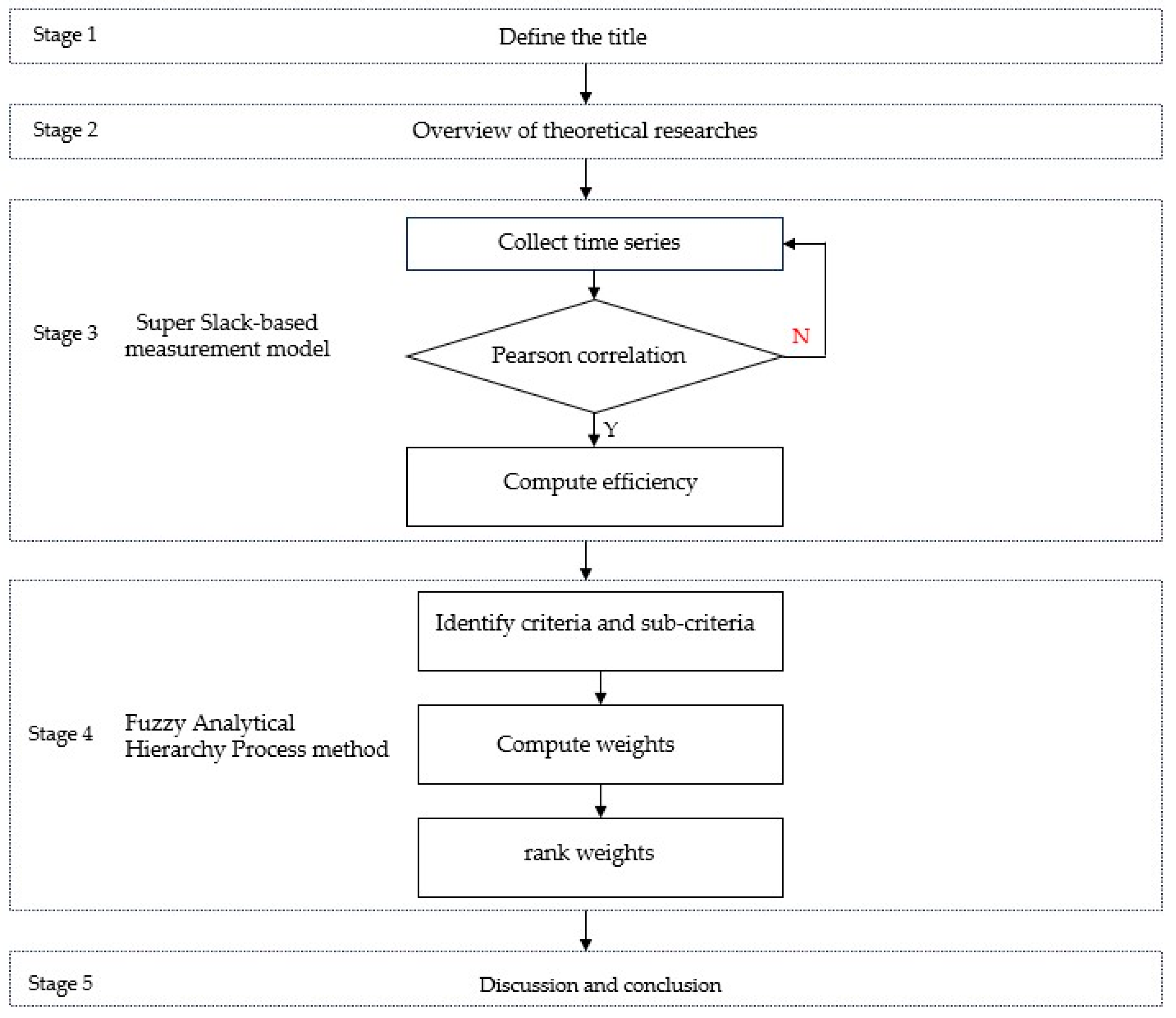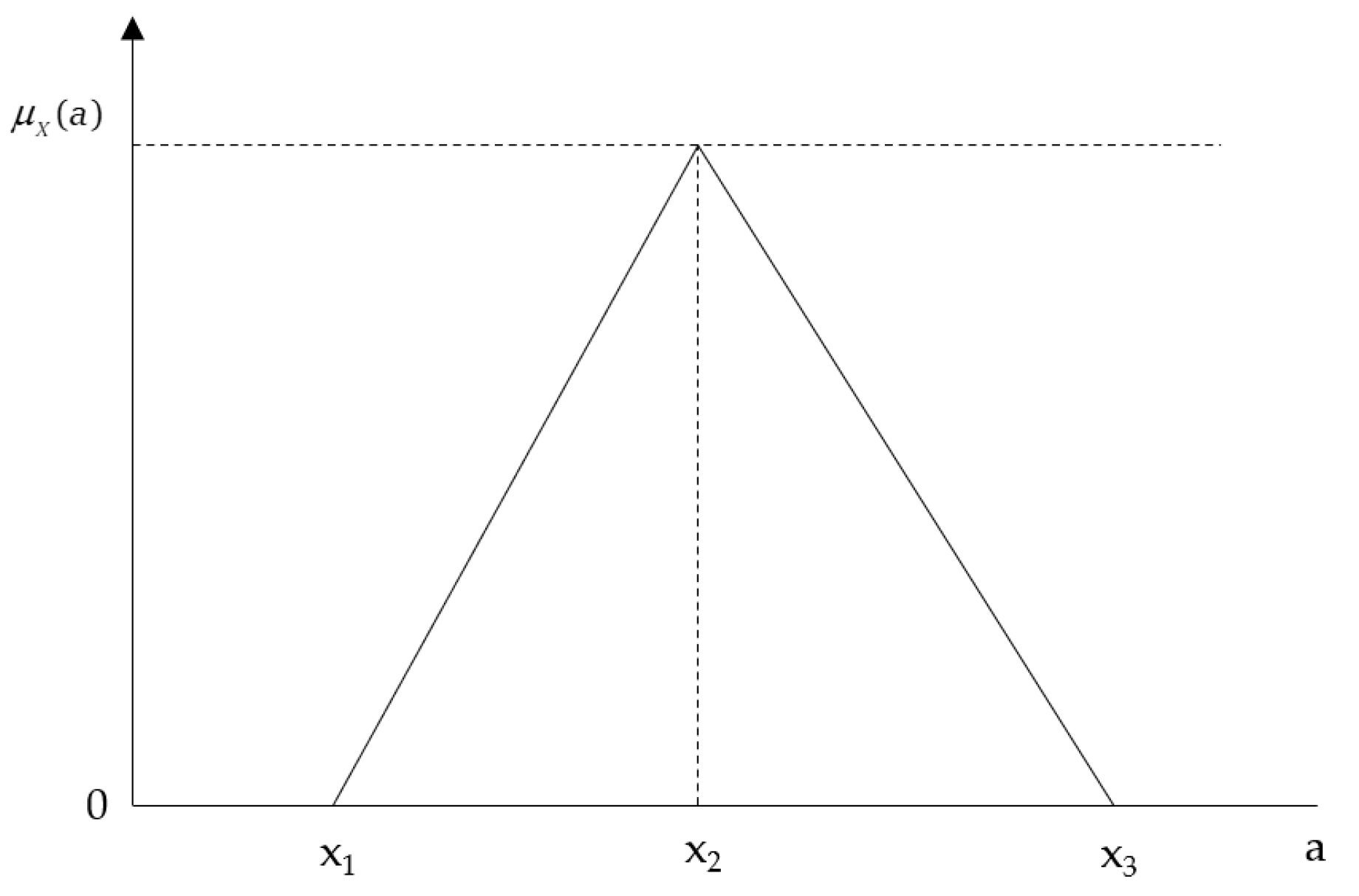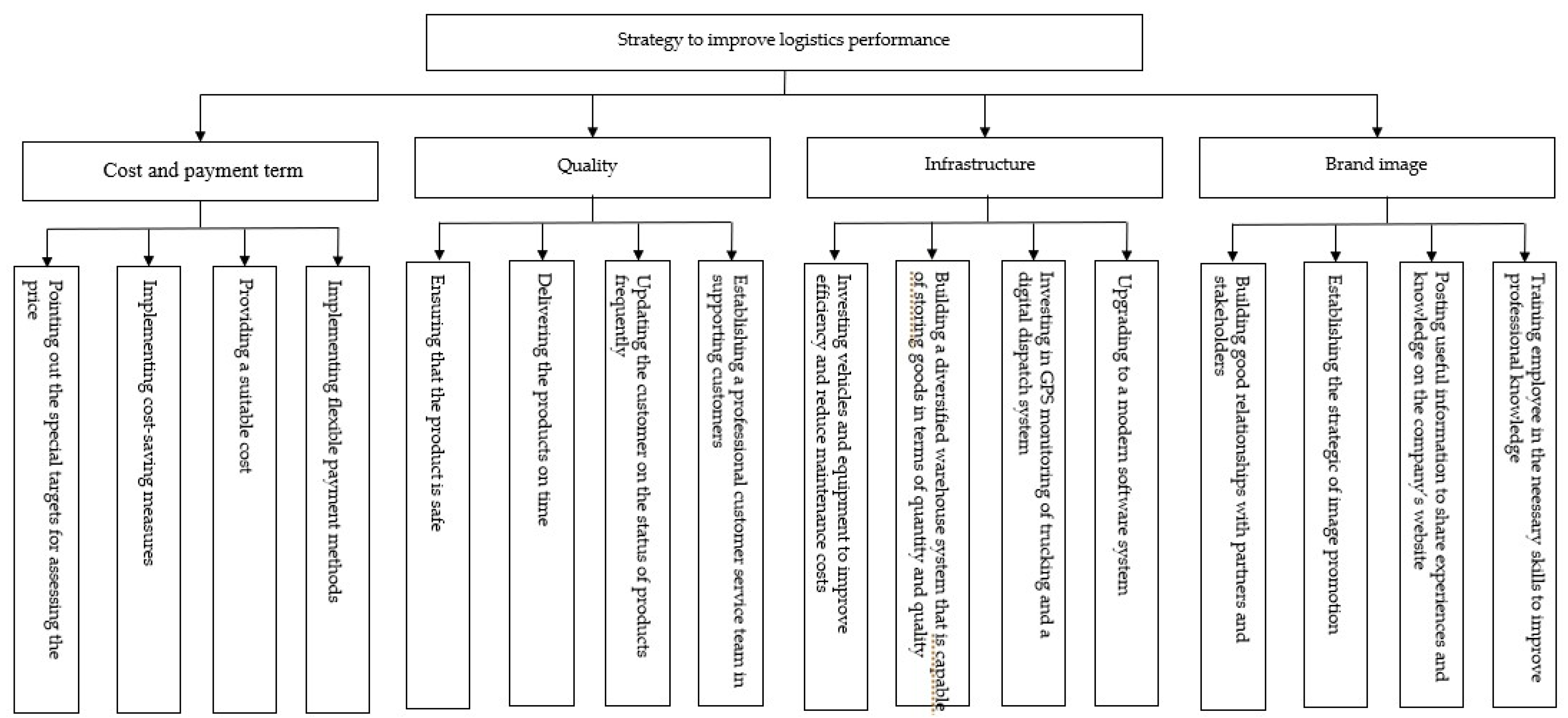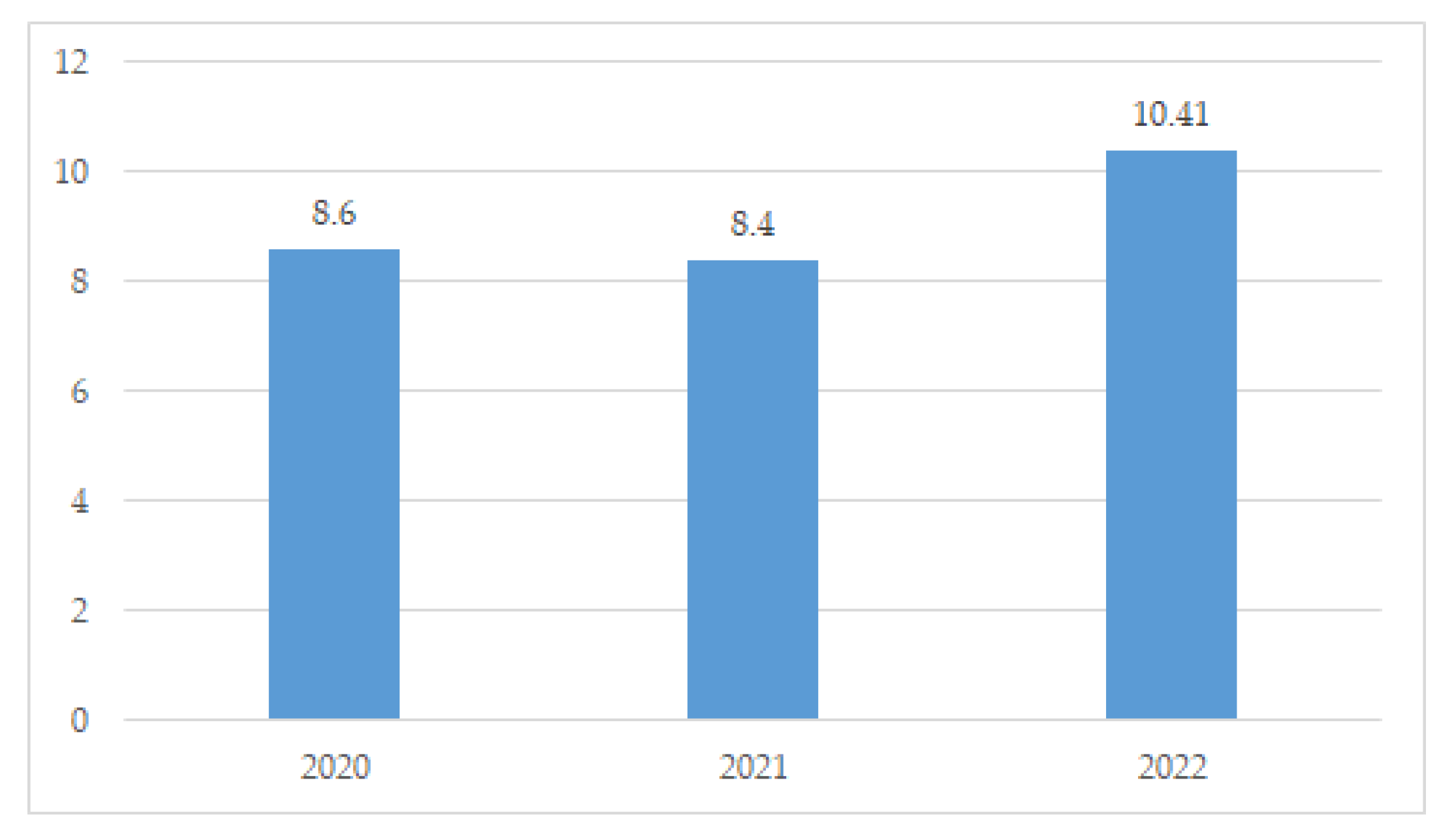An Integrated Approach of Fuzzy Analytic Hierarchy Process and Super Slack-Based Measure for the Logistics Industry in Vietnam
Abstract
1. Introduction
2. Literature Review
3. Methods
3.1. Research Framework
3.2. Super-SBM Model
3.3. Fuzzy Analytic Hierarchy Process
3.3.1. Triangular Fuzzy Number
3.3.2. Fuzzy Linguistic Scale
3.3.3. Fuzzy AHP Algorithm
4. Results
4.1. Efficiency Measurement
4.1.1. Data Analysis
4.1.2. Pearson Correlation Coefficient
4.1.3. Business Efficiency
4.2. Performance Improvement Direction
4.2.1. Strategic Structure in Business
4.2.2. Analysis Results of Criteria
5. Discussion
6. Conclusions
Author Contributions
Funding
Institutional Review Board Statement
Informed Consent Statement
Data Availability Statement
Acknowledgments
Conflicts of Interest
Appendix A
| Indication | Years | (I)CA | (I)NCA | (I)OE | (O)NR | (O)NPFT |
|---|---|---|---|---|---|---|
| Max | 2016 | 22,151 | 25,185 | 25,054 | 14,633 | 2718 |
| Min | 320 | 73 | 377 | 616 | 33 | |
| Average | 4403 | 6814 | 4921 | 4354 | 501 | |
| SD | 6766 | 9040 | 7374 | 4864 | 806 | |
| Max | 2017 | 26,343 | 22,820 | 27,384 | 13,830 | 4122 |
| Min | 458 | 54 | 388 | 627 | 53 | |
| Average | 4966 | 6313 | 5491 | 4675 | 781 | |
| SD | 7896 | 8238 | 8072 | 5057 | 1201 | |
| Max | 2018 | 31,264 | 22,260 | 30,749 | 16,090 | 6148 |
| Min | 410 | 280 | 404 | 639 | 64 | |
| Average | 5618 | 6135 | 6122 | 5088 | 963 | |
| SD | 9379 | 7702 | 9085 | 5304 | 1844 | |
| Max | 2019 | 37,291 | 20,885 | 36,757 | 18,329 | 8214 |
| Min | 367 | 421 | 452 | 560 | 52 | |
| Average | 6368 | 5967 | 7056 | 5222 | 1195 | |
| SD | 11252 | 7099 | 10883 | 5690 | 2492 | |
| Max | 2020 | 37,974 | 18,928 | 37,565 | 9972 | 1642 |
| Min | 395 | 359 | 462 | 518 | 60 | |
| Average | 6702 | 5432 | 7235 | 4031 | 468 | |
| SD | 11421 | 6347 | 11066 | 3218 | 472 | |
| Max | 2021 | 37,568 | 17,412 | 37,653 | 13,267 | 3189 |
| Min | 542 | 329 | 658 | 609 | 56 | |
| Average | 7138 | 5456 | 7778 | 4502 | 767 | |
| SD | 11286 | 5917 | 11046 | 3811 | 897 | |
| Max | 2022 | 40,221 | 19,817 | 43,806 | 14,350 | 7127 |
| Min | 507 | 280 | 737 | 585 | 82 | |
| Average | 7630 | 5911 | 9047 | 5531 | 1459 | |
| SD | 12,040 | 6568 | 12,919 | 5115 | 2129 |
| Variables | Years | (I)CA | (I)NCA | (I)OE | (O)NR | (O)NPAT |
|---|---|---|---|---|---|---|
| (I)CA | 2016 | 1.00000 | 0.92139 | 0.98540 | 0.75533 | 0.89535 |
| (I)NCA | 0.92139 | 1.00000 | 0.85088 | 0.92967 | 0.66602 | |
| (I)OE | 0.98540 | 0.85088 | 1.00000 | 0.65281 | 0.95649 | |
| (O)NR | 0.75533 | 0.92967 | 0.65281 | 1.00000 | 0.42586 | |
| (O)NPAT | 0.89535 | 0.66602 | 0.95649 | 0.42586 | 1.00000 | |
| (I)CA | 2017 | 1.00000 | 0.87790 | 0.99728 | 0.83220 | 0.98353 |
| (I)NCA | 0.87790 | 1.00000 | 0.86397 | 0.98383 | 0.78969 | |
| (I)OE | 0.99728 | 0.86397 | 1.00000 | 0.81680 | 0.98705 | |
| (O)NR | 0.83220 | 0.98383 | 0.81680 | 1.00000 | 0.73336 | |
| (O)NPAT | 0.98353 | 0.78969 | 0.98705 | 0.73336 | 1.00000 | |
| (I)CA | 2018 | 1.00000 | 0.88469 | 0.99832 | 0.87881 | 0.97220 |
| (I)NCA | 0.88469 | 1.00000 | 0.89262 | 0.98206 | 0.75441 | |
| (I)OE | 0.99832 | 0.89262 | 1.00000 | 0.88583 | 0.96822 | |
| (O)NR | 0.87881 | 0.98206 | 0.88583 | 1.00000 | 0.75862 | |
| (O)NPAT | 0.97220 | 0.75441 | 0.96822 | 0.75862 | 1.00000 | |
| (I)CA | 2019 | 1.00000 | 0.87773 | 0.99863 | 0.91968 | 0.97899 |
| (I)NCA | 0.87773 | 1.00000 | 0.88684 | 0.98120 | 0.77050 | |
| (I)OE | 0.99863 | 0.88684 | 1.00000 | 0.92947 | 0.97642 | |
| (O)NR | 0.91968 | 0.98120 | 0.92947 | 1.00000 | 0.84384 | |
| (O)NPAT | 0.97899 | 0.77050 | 0.97642 | 0.84384 | 1.00000 | |
| (I)CA | 2020 | 1.00000 | 0.89029 | 0.99843 | 0.60807 | 0.88362 |
| (I)NCA | 0.89029 | 1.00000 | 0.88254 | 0.88381 | 0.72344 | |
| (I)OE | 0.99843 | 0.88254 | 1.00000 | 0.60578 | 0.90665 | |
| (O)NR | 0.60807 | 0.88381 | 0.60578 | 1.00000 | 0.51587 | |
| (O)NPAT | 0.88362 | 0.72344 | 0.90665 | 0.51587 | 1.00000 | |
| (I)CA | 2021 | 1.00000 | 0.88665 | 0.99773 | 0.29993 | 0.30724 |
| (I)NCA | 0.88665 | 1.00000 | 0.88160 | 0.69276 | 0.67083 | |
| (I)OE | 0.99773 | 0.88160 | 1.00000 | 0.29169 | 0.28232 | |
| (O)NR | 0.29993 | 0.69276 | 0.29169 | 1.00000 | 0.90929 | |
| (O)NPAT | 0.30724 | 0.67083 | 0.28232 | 0.90929 | 1.00000 | |
| (I)CA | 2022 | 1.00000 | 0.90249 | 0.99870 | 0.77528 | 0.99705 |
| (I)NCA | 0.90249 | 1.00000 | 0.91209 | 0.96945 | 0.92440 | |
| (I)OE | 0.99870 | 0.91209 | 1.00000 | 0.78834 | 0.99842 | |
| (O)NR | 0.77528 | 0.96945 | 0.78834 | 1.00000 | 0.80503 | |
| (O)NPAT | 0.99705 | 0.92440 | 0.99842 | 0.80503 | 1.00000 |
References
- Chung, S.H. Applications of smart technologies in logistics and transport: A review. Transp. Res. E Logist. Transp. Rev. 2021, 153, 102455. [Google Scholar] [CrossRef]
- Orozonova, A.; Gapurbaeva, S.; Kydykov, A.; Prokopenko, O.; Prause, P.; Lytvynenko, S. Application of smart logistics technologies in the organization of multimodal cargo delivery. Transp. Res. Procedia 2022, 63, 1192–1198. [Google Scholar] [CrossRef]
- Barreto, L.; Amaral, A.; Pereira, T. Industry 4.0 implications in logistics: An overview. Procedia Manuf. 2017, 13, 1245–1252. [Google Scholar] [CrossRef]
- Holubčík, M.; Koman, G.; Soviar, J. Industry 4.0 in Logistics Operations. Transp. Res. Procedia 2021, 53, 282–288. [Google Scholar] [CrossRef]
- Mariusz, K.; Ludmiła, F.D.; Szymon, W. Modern technologies development in logistics centers: The case study of Poland. Transp. Res. Procedia 2021, 55, 268–275. [Google Scholar]
- Šourek, D. Software Support of City Logistics’ Processes. Transp. Res. Procedia 2021, 55, 172–179. [Google Scholar] [CrossRef]
- Voronova, O. Improvement of warehouse logistics based on the introduction of lean manufacturing principles. Transp. Res. Procedia 2022, 63, 919–928. [Google Scholar] [CrossRef]
- Nechaev, A.; Barykina, Y.; Tyapkina, M. Development of methodological approaches to improve the transport and logistics system using the international leasing. Transp. Res. Procedia 2022, 63, 441–448. [Google Scholar] [CrossRef]
- Statistics. Size of the Logistics Industry Worldwide 2018–2022. 2023. Available online: https://www.statista.com/statistics/943517/logistics-industry-global-cagr/ (accessed on 1 May 2023).
- The State President. Commercial law. No. 36/2005/QH11. 2005. Available online: https://thuvienphapluat.vn/van-ban/Thuong-mai/Luat-Thuong-mai-2005-36-2005-QH11-2633.aspx (accessed on 1 May 2023).
- Statistics. GDP Contribution of the Transportation and Storage Sector in Vietnam from 2015 to 2021. 2023. Available online: https://www.statista.com/statistics/1047729/vietnam-gdp-contribution-of-transportation-and-storage-sector/ (accessed on 1 May 2023).
- Pham, H.C.; Nguyen, T.T.; Scott, M.; Tran, K.N.Q. Information Sharing in Logistics Firms: An Exploratory Study of the Vietnamese Logistics Sector. Asian J. Shipp. Logist. 2019, 35, 87–95. [Google Scholar] [CrossRef]
- Liu, L.; Long, Z.; Kou, C.; Guo, H.; Li, X. Evaluation of the Environmental Cost of Integrated Inbound Logistics: A Case Study of a Gigafactory of a Chinese Logistics Firm. Sustainability 2023, 15, 11520. [Google Scholar] [CrossRef]
- Wang, R.; Li, J.; Bai, R. Prediction and Analysis of Container Terminal Logistics Arrival Time Based on Simulation Interactive Modeling: A Case Study of Ningbo Port. Mathematics 2023, 11, 3271. [Google Scholar] [CrossRef]
- Risberg, A.; Jafari, H.; Sandberg, E. A configurational approach to last mile logistics practices and omni-channel firm characteristics for competitive advantage: A fuzzy-set qualitative comparative analysis. Int. J. Phys. Distrib. Logist. Manag. 2023, 53, 53–70. [Google Scholar] [CrossRef]
- Dalila, R. Tracking the Van: The role of forward linkages in logistics MNEs’ location choices across European NUTS 3 regions. Pap. Reg. Sci. 2023, 102, 217–460. [Google Scholar]
- Nataraj, S.; Alvarez, C.; Sada, L.; Juan, A.A.; Panadero, J.; Bayliss, C. Applying Statistical Learning Methods for Forecasting Prices and Enhancing the Probability of Success in Logistics Tenders. Transp. Res. Procedia 2020, 47, 529–536. [Google Scholar] [CrossRef]
- De Souza, E.D.; Kerber, J.C.; Bouzon, M.; Rodriguez, C.M.T. Performance evaluation of green logistics: Paving the way towards circular economy. Clean. Logist. Supply Chain 2022, 3, 100019. [Google Scholar] [CrossRef]
- Tikwayo, L.N.; Mathaba, T.N.D. Applications of Industry 4.0 Technologies in Warehouse Management: A Systematic Literature Review. Logistics 2023, 7, 24. [Google Scholar] [CrossRef]
- Zaare, T.F.; Daneshvar, S. Benchmark Approach for Efficiency Improvement in Green Supply Chain Management with DEA Models. Sustainability 2023, 15, 4433. [Google Scholar] [CrossRef]
- Le, V.H.; Dang, Q.H. The Factors Affecting Digital Transformation in Vietnam Logistics Enterprises. Electronics 2023, 12, 1825. [Google Scholar]
- Wang, C.N.; Day, J.D.; Lien, N.T.K.; Chien, L.Q. Integrating the Additive Seasonal Model and Super-SBM Model to Compute the Efficiency of Port Logistics Companies in Vietnam. Sustainability 2018, 10, 2782. [Google Scholar] [CrossRef]
- Marto, M.; Lourenço, M.J.; Madaleno, M. An Evaluation of the Efficiency of Tertiary Education in the Explanation of the Performance of GDP per Capita Applying Data Envelopment Analysis (DEA). Sustainability 2022, 14, 15524. [Google Scholar] [CrossRef]
- Goyal, M.; Lu, J.; Zhang, G. Decision Making in Multi-Issue e-Market Auction Using Fuzzy Techniques and Negotiable Attitudes. J. Theor. Appl. Electron. Commer. Res. 2008, 3, 97–110. [Google Scholar] [CrossRef][Green Version]
- Dogan, O. A Recommendation System in E-Commerce with Profit-Support Fuzzy Association Rule Mining (P-FARM). J. Theor. Appl. Electron. Commer. Res. 2023, 18, 831–847. [Google Scholar] [CrossRef]
- Chen, Y.; Du, J.; Hoa, J. Super-efficiency based on a modified directional distance function. Omega 2013, 41, 621–625. [Google Scholar] [CrossRef]
- Zhou, C.S.; Shi, C.Y.; Wang, S.J.; Zhang, G.J. Estimation of eco-efficiency and its influencing factors in Guangdong province based on Super-SBM and panel regression models. Ecol. Indic. 2018, 86, 67–80. [Google Scholar] [CrossRef]
- Wang, C.N.; Hsu, H.P.; Wang, J.W.; Kao, Y.C.; Nguyen, T.P. Strategic Alliance for Vietnam Domestic Real Estate Companies Using a Hybrid Approach Combining GM (1,1) with Super SBM DEA. Sustainability 2020, 12, 1891. [Google Scholar] [CrossRef]
- Huang, Y.S.; Liu, S.J. Efficiency evaluation of a sustainable hydrogen production scheme based on super efficiency SBM model. J. Clean. Prod. 2020, 256, 120447. [Google Scholar] [CrossRef]
- Du, Y.W.; Jiang, J.; Li, C.H. Ecological efficiency evaluation of marine ranching based on the Super-SBM model: A case study of Shandong. J. Clean. Prod. 2021, 131, 108174. [Google Scholar] [CrossRef]
- Ma, F.N.; Li, J.Y.; Ma, H.W.; Sun, Y. Evaluation of the Regional Financial Efficiency Based on SBM-Shannon Entropy model. Procedia Comput. Sci. 2022, 199, 954–961. [Google Scholar] [CrossRef]
- Emrouznejad, A.; Marra, M. The state of the art development of AHP (1979–2017): A literature review with a social network analysis. Int. J. Prod. Res. 2017, 55, 6653–6675. [Google Scholar] [CrossRef]
- Liu, Y.; Eckert, C.M.; Earl, C. A review of fuzzy AHP methods for decision-making with subjective judgements. Expert Syst. Appl. 2020, 161, 113738. [Google Scholar] [CrossRef]
- Rezaie, K.; Ramiyani, S.S.; Nazari-Shirkouhi, S.; Badizadeh, A. Evaluating performance of Iranian cement firms using an integrated fuzzy AHP–VIKOR method. Appl. Math. Model. 2014, 38, 5033–5046. [Google Scholar] [CrossRef]
- Ali, N.; Mohammad, H.K.; Majid, G. Application of fuzzy AHP method to IOCG prospectivity mapping: A case study in Taherabad prospecting area, eastern Iran. Int. J. Appl. Earth Obs. Geoinf. 2014, 33, 142–154. [Google Scholar]
- Choosakun, A.; Yeom, C. Developing Evaluation Framework for Intelligent Transport System on Public Transportation in Bangkok Metropolitan Regions Using Fuzzy AHP. Infrastructures 2021, 6, 182. [Google Scholar] [CrossRef]
- Wang, G.; Liu, L.; Shi, P.; Zhang, G.; Liu, J. Flood Risk Assessment of Metro System Using Improved Trapezoidal Fuzzy AHP: A Case Study of Guangzhou. Remote Sens. 2021, 13, 5154. [Google Scholar] [CrossRef]
- Şahin, Y.; Kulakli, A. Evaluation of Open and Distance Education Websites: A Hybrid Multi-Criteria Decision-Making Approach. Systems 2023, 11, 58. [Google Scholar] [CrossRef]
- Cooper, J.O.; Heron, T.E.; Heward, W.L. Applied Behavior Analysis; Pearson: New York, NY, USA, 2007. [Google Scholar]
- Charnes, A.; Cooper, W.W.; Rhodes, E. Measuring the Efficiency of Decision-Making Units. Eur. J. Oper. Res. 1978, 2, 429–444. [Google Scholar] [CrossRef]
- Tone, K. A slacks-based measure of efficiency in data envelopment analysis. Eur. J. Oper. Res. 2001, 130, 498–509. [Google Scholar] [CrossRef]
- Andersen, P.; Niels, C.P. A Procedure for Ranking Efficient Units in Data Envelopment Analysis. Manag. Sci. 1993, 39, 1261–1264. [Google Scholar] [CrossRef]
- Tone, K. A slacks-based measure of super-efficiency in data envelopment analysis. Eur. J. Oper. Res. 2002, 243, 32–41. [Google Scholar] [CrossRef]
- Saaty, T.L. Decision-making with the AHP: Why is the principal eigenvector necessary. Eur. J. Oper. Res. 2003, 145, 85–91. [Google Scholar] [CrossRef]
- Cheng, C.H. Group opinion aggregation based on a grading process: A method for constructing triangular fuzzy numbers. Comput. Math. Appl. 2004, 48, 1619–1632. [Google Scholar] [CrossRef]
- Ballı, S.; Korukoğlu, S. Operating System Selection Using Fuzzy AHP and TOPSIS Methods. Math. Comput. Appl. 2009, 14, 119–130. [Google Scholar] [CrossRef]
- Ryjov, A. Fuzzy Linguistic Scales: Definition, Properties and Applications. In Soft Computing in Measurement and Information Acquisition; Reznik, L., Kreinovich, V., Eds.; Studies in Fuzziness and Soft Computing; Springer: Berlin/Heidelberg, Germany, 2003; Volume 127, pp. 23–38. [Google Scholar]
- Ryjov, A. The Degree of Fuzziness of Fuzzy Descriptions. In Mathematical Cybernetics and its Application to Biology; Moscow University Publishing: Moscow, Russia, 1987; pp. 60–77. [Google Scholar]
- Ryjov, A. The Axiomatic Definition of a Linguistic Scale Fuzziness Degree, Its Major Properties and Applications; Johnson Space Center, North American Fuzzy Logic Proceeding Society (NAFIPS’92); NASA: Houston, TX, USA, 1992; pp. 21–29. [Google Scholar]
- Deliktas, D.; Ustun, O. Multiple criteria decision-making approach for industrial engineer selection using fuzzy AHP-Fuzzy TOPSIS. Anadolu Univ. J. Sci. Technol. A—Appl. Sci. Eng. 2018, 19, 58–82. [Google Scholar] [CrossRef]
- Buckley, J.J. Fuzzy hierarchical analysis. Fuzzy Sets Syst. 1985, 17, 233–247. [Google Scholar] [CrossRef]
- Dwi, P.; Mochammad, S. Fuzzy Analytical Hierarchy Process Method to Determine the Quality of Gemstones. Adv. Fuzzy Syst. 2018, 2018, 9094380. [Google Scholar]
- Chen, S.J.; Hwang, C.L. Fuzzy Multiple Attribute Decision Making; Springer: New York, NY, USA, 1992. [Google Scholar]
- Zadeh, L.A. Fuzzy sets. Inf. Control. 1965, 8, 338–353. [Google Scholar] [CrossRef]
- Vietstock. 2023. Available online: https://finance.vietstock.vn/ (accessed on 19 January 2023).
- López, F.J.; Ho, J.C.; Ruiz-Torres, A.J. A computational analysis of the impact of correlation and data translation on DEA efficiency score. J. Ind. Prod. Eng. 2016, 33, 192–204. [Google Scholar] [CrossRef]
- Kirch, W. Pearson’s Correlation Coefficient. In Encyclopedia of Public Health; Springer: Dordrecht, Germany, 2008; pp. 1090–1091. [Google Scholar]
- Daniel, F.L.; Scott, B.K.; John, O. The effects of logistics capabilities and strategy on firm performance. J. Bus. Logist. 2000, 21, 47–67. [Google Scholar]
- David, W.H.; Paul, C.H.; Daniel, Y.L. Critical factors that affect logistics performance: A comparison of China, Japan and Korea. Int. J. Shipp. Transp. Logist. 2017, 9, 107–129. [Google Scholar]
- Pham, V.H.; Nguyen, T.T. Factors affecting marketing strategy of logistics business—Case of Vietnam. Asian J. Shipp. Logist. 2020, 36, 224–234. [Google Scholar]
- Martin, P. Global Logistics Market Size by Region 2020. 2022. Available online: https://www.statista.com/statistics/1069868/total-global-logistics-market-size-region/ (accessed on 3 June 2023).
- Martin, P. Logistics Industry Worldwide—Statistics & Facts. 2023. Available online: https://www.statista.com/topics/5691/logistics-industry-worldwide/#topicOverview (accessed on 3 June 2023).
- Mladen, K.; Giulio, P.A.; Pier, P.M.; Snežana, T. Evaluation of the smart reverse logistics development scenarios using a novel MCDM model. Clean. Environ. Syst. 2022, 7, 100099. [Google Scholar]





| Fuzzy Number | Linguistic Scale | Scale of Fuzzy Number | Positive Reciprocal Fuzzy Scale |
|---|---|---|---|
| Equal importance | (1, 1, 1) | (1, 1, 1) | |
| Intermediate values between and | (1, 2, 3) | (1, 1/2, 1/3) | |
| Moderate importance | (2, 3, 4) | (1/2, 1/3, 1/4) | |
| Intermediate values between and | (3, 4, 5) | (1/3, 1/4, 1/5) | |
| Essential importance | (4, 5, 6) | (1/4, 1/5, 1/6) | |
| Intermediate values between and | (5, 6, 7) | (1/5, 1/6, 1/7) | |
| Very vital importance | (6, 7, 8) | (1/6, 1/7, 1/8) | |
| Intermediate values between and | (7, 8, 9) | (1/7, 1/8, 1/9) | |
| Extremely vital importance | (9, 9, 9) | (1/9, 1/9, 1/9) |
| DMUs | 2016 | 2017 | 2018 | 2019 | 2020 | 2021 | 2022 |
|---|---|---|---|---|---|---|---|
| PVT | 1.47896 | 1.21982 | 1.55269 | 1.62353 | 3.07727 | 0.71634 | 1.10850 |
| MVN | 2.53397 | 2.53341 | 2.16434 | 2.14556 | 3.03102 | 1.00000 | 2.58562 |
| PVP | 0.28561 | 0.30384 | 0.54837 | 0.71986 | 1.09951 | 0.72758 | 0.75669 |
| GSP | 5.62939 | 8.09925 | 3.39223 | 2.59714 | 2.65493 | 1.89795 | 1.95881 |
| ACV | 1.00000 | 1.00000 | 1.00000 | 1.00000 | 1.00000 | 0.12322 | 1.00000 |
| PHP | 1.37765 | 0.57517 | 0.68637 | 0.63470 | 1.21104 | 0.74996 | 0.81636 |
| DVP | 2.32096 | 1.29849 | 1.99321 | 1.67440 | 2.09580 | 2.35935 | 2.52588 |
| TMS | 1.67996 | 1.16393 | 1.23256 | 1.09705 | 1.15367 | 1.72052 | 1.26460 |
| STG | 0.50510 | 1.66195 | 0.58248 | 0.66432 | 0.66694 | 1.10816 | 1.09653 |
| Main Criteria | Sub-Criteria | Description |
|---|---|---|
| M1—Cost and payment term | S11—Pointing out the special targets for assessing the price | The cost of each transportation type and the suitable payment term should be determined with detailed information. |
| S12—Implementing cost-saving measures | ||
| S13—Providing a suitable cost | ||
| S14—Implementing flexible payment methods | ||
| M2—Quality | S21—Ensuring that the product is safe | The goods are not damaged in transit are delivered in a timely manner. Additionally, the logistics company should follow-up closely and inform the consumer of the status of shipments frequently. |
| S22—Delivering the products on time | ||
| S23—Updating the customer on the status of products frequently | ||
| S24—Establishing a professional customer service team in supporting customers | ||
| M3—Infrastructure | S31—Investing vehicles and equipment to improve efficiency and reduce maintenance costs | |
| S32—Building a diversified warehouse system that is capable of storing goods in terms of quantity and quality | ||
| S33—Investing in GPS monitoring of trucking and a digital dispatch system | ||
| S34—Upgrading to a modern software system | ||
| M4—Brand image | S41—Building good relationships with partners and stakeholders | |
| S42—Establishing the strategic of image promotion | ||
| S43—Posting useful information to share experiences and knowledge on the company’s website | ||
| S44—Training employees in the necessary skills to improve professional knowledge |
| Main Criteria | Weights | Sub Criteria | Weights | Integrated Weight | Rank |
|---|---|---|---|---|---|
| M1 | 0.25905 | S11 | 0.29363 | 0.07022 | 6 |
| S12 | 0.24089 | 0.05761 | 8 | ||
| S13 | 0.41784 | 0.09993 | 4 | ||
| S14 | 0.04764 | 0.01139 | 16 | ||
| M2 | 0.57556 | S21 | 0.41792 | 0.14414 | 1 |
| S22 | 0.33007 | 0.07894 | 5 | ||
| S23 | 0.09161 | 0.02460 | 12 | ||
| S24 | 0.16040 | 0.04056 | 11 | ||
| M3 | 0.05868 | S31 | 0.30444 | 0.06789 | 7 |
| S32 | 0.44953 | 0.10751 | 3 | ||
| S33 | 0.07213 | 0.01645 | 15 | ||
| S34 | 0.17390 | 0.04159 | 10 | ||
| M4 | 0.10671 | S41 | 0.57983 | 0.13867 | 2 |
| S42 | 0.15936 | 0.03811 | 12 | ||
| S43 | 0.07718 | 0.01846 | 14 | ||
| S44 | 0.18363 | 0.04392 | 9 |
Disclaimer/Publisher’s Note: The statements, opinions and data contained in all publications are solely those of the individual author(s) and contributor(s) and not of MDPI and/or the editor(s). MDPI and/or the editor(s) disclaim responsibility for any injury to people or property resulting from any ideas, methods, instructions or products referred to in the content. |
© 2023 by the authors. Licensee MDPI, Basel, Switzerland. This article is an open access article distributed under the terms and conditions of the Creative Commons Attribution (CC BY) license (https://creativecommons.org/licenses/by/4.0/).
Share and Cite
Nguyen, T.K.L.; Nguyen, T.L.H.; Ngo, T.L.; Hoang, B.A.; Le, H.H.; Tran, T.T.H. An Integrated Approach of Fuzzy Analytic Hierarchy Process and Super Slack-Based Measure for the Logistics Industry in Vietnam. Sustainability 2023, 15, 12654. https://doi.org/10.3390/su151612654
Nguyen TKL, Nguyen TLH, Ngo TL, Hoang BA, Le HH, Tran TTH. An Integrated Approach of Fuzzy Analytic Hierarchy Process and Super Slack-Based Measure for the Logistics Industry in Vietnam. Sustainability. 2023; 15(16):12654. https://doi.org/10.3390/su151612654
Chicago/Turabian StyleNguyen, Thi Kim Lien, Thi Lan Huong Nguyen, Tri Long Ngo, Bang An Hoang, Hong Huyen Le, and Thi Thanh Hong Tran. 2023. "An Integrated Approach of Fuzzy Analytic Hierarchy Process and Super Slack-Based Measure for the Logistics Industry in Vietnam" Sustainability 15, no. 16: 12654. https://doi.org/10.3390/su151612654
APA StyleNguyen, T. K. L., Nguyen, T. L. H., Ngo, T. L., Hoang, B. A., Le, H. H., & Tran, T. T. H. (2023). An Integrated Approach of Fuzzy Analytic Hierarchy Process and Super Slack-Based Measure for the Logistics Industry in Vietnam. Sustainability, 15(16), 12654. https://doi.org/10.3390/su151612654







